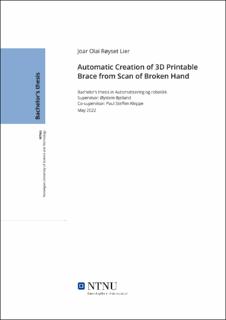| dc.contributor.advisor | Bjelland, Øystein | |
| dc.contributor.advisor | Kleppe, Paul Steffen | |
| dc.contributor.author | Joar Olai Røyset Lier | |
| dc.date.accessioned | 2022-07-05T17:21:39Z | |
| dc.date.available | 2022-07-05T17:21:39Z | |
| dc.date.issued | 2022 | |
| dc.identifier | no.ntnu:inspera:110437709:110437898 | |
| dc.identifier.uri | https://hdl.handle.net/11250/3002895 | |
| dc.description.abstract | Målet med dette prosjektet var å lage et brukervennlig automatisk program for å 3d-skanne hånden, med intensjonen om at dette senere skulle brukes til å lage en pasientspesifikk støtteskinne for håndbrudd. Resultatet var at programmet laget i denne rapporten var helautomatisk i å lage modellen av hånden. En test viser også at det fungerer på forskjellige mennesker. På slutten av prosjektet hadde det fysiske systemet fortsatt to problemer som skulle løses. Den første var en liten slakk i systemet, som gjorde at underarmen på bøylen ble for stor. Det andre var lysforholdene. På grunn av de varierende lysforholdene kan det være steder på hånden som 3d-skanneren ikke kan lese.
Skanningsprosessen går ut på at pasienten holder hånden på en støtte foran et dybdekamera, deretter starter en operatør skanneprogrammet og roterer dybdekameraet rundt hånden. I gjennomsnitt var én av tre skanninger bra. Etter dette kjøres det automatiske databehandlingsprogrammet. Hvis skanneresultatet er godt nok, vil det sende ut 3d-modellen. Hvis ikke for slakk i det fysiske systemet, ville denne 3d-modellen vært god nok til å bli brukt til å lage en bøyle.
Det automatiserte databehandlingsprogrammet følger denne prosedyren.
1. Gjør dybdebildet til en punktsky.
2. Slå sammen den forskjellige punktskyen til et enkelt koordinatsystem
3. Glatt ut punktskyen.
4. Gjør om punktskyen til en 3d-modell.
5. Sampler 3d-modellen og lag deretter en ny 3d-modell med disse punktene.
6. Glatt 3d-modellen.
7. Til slutt, forstørr 3d-modellen. | |
| dc.description.abstract | The goal of this project was to make an easy-to-use automatic program to 3d scan the hand, with the intention of this later being used to create a patient-specific brace for hand fractures. The result was that the program made in this report was fully automatic in creating the model of the hand. Also, a test show that it works on different people. At the end of the project, the physical system still had two issues that should be resolved. The first was a slight slack in the system, that made the forearm of the brace too big. The second were the lighting conditions. Because of the variable lighting conditions there could be places on the hand that the 3d scanner can't read.
The scanning process is that the patient holds the hand on a support in front of a depth camera, then an operator starts the scanning program and rotates the depth camera around the hand. On average one out of three scans were good. After this, the automatic data processing program is run. If the scan result is good enough it will output the 3d model. If not for the slack in the physical system, this 3d model would have been good enough to be used for create a brace.
The automated data processing program follows this procedure.
1. Turn the depth image into a point cloud.
2. Merge the different point cloud into a single coordinate system
3. Smooth the point cloud.
4. Turn the point cloud into a 3d model.
5. Sample points from the 3d model and then make a new 3d model with these points.
6. Smooth the 3d model.
7. Finally enlarge the 3d model. | |
| dc.language | eng | |
| dc.publisher | NTNU | |
| dc.title | Automatic Creation of 3D Printable Brace from Scan of Broken Hand | |
| dc.type | Bachelor thesis | |
